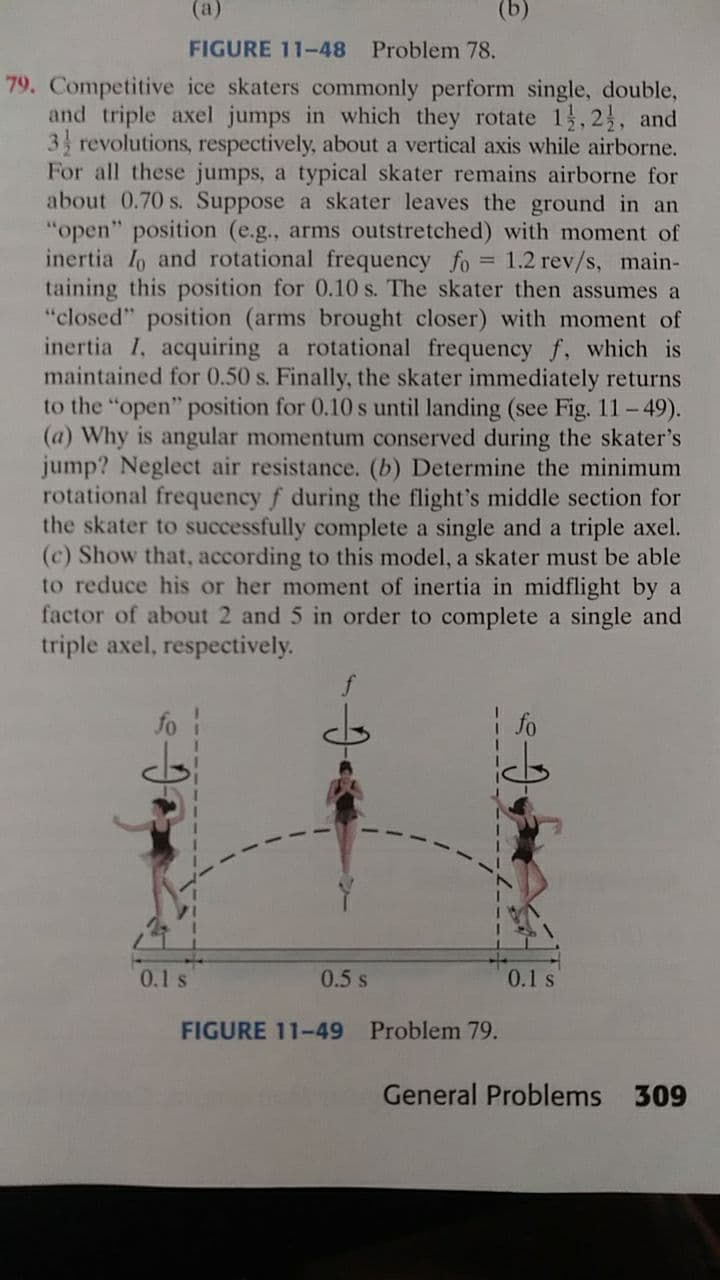FIGURE 11-48 Problem 78. 79. Competitive ice skaters commonly perform single, double, and triple axel jumps in which they rotate 1, 2 , and 3 revolutions, respectively, about a vertical axis while airborne. For all these jumps, a typical skater remains airborne for about 0.70 s. Suppose a skater leaves the ground in an "open" position (e.g., arms outstretched) with moment of inertia Io and rotational frequency fo 1.2 rev/s, main- taining this position for 0.10 s. The skater then assumes a "closed" position (arms brought closer) with moment of inertia I, acquiring a rotational frequency f, which is maintained for 0.50 s. Finally, the skater immediately returns to the "open" position for 0.10 s until landing (see Fig. 11-49). (a) Why is angular momentum conserved during the skater's jump? Negleet air resistance. (b) Determine the minimum rotational frequency f during the flight's middle section for the skater to successfully complete a single and a triple axel. (c) Show that, according to this model, a skater must be able to reduce his or her moment of inertia in midflight by a factor of about 2 and 5 in order to complete a single and triple axel, respectively. %3D
FIGURE 11-48 Problem 78. 79. Competitive ice skaters commonly perform single, double, and triple axel jumps in which they rotate 1, 2 , and 3 revolutions, respectively, about a vertical axis while airborne. For all these jumps, a typical skater remains airborne for about 0.70 s. Suppose a skater leaves the ground in an "open" position (e.g., arms outstretched) with moment of inertia Io and rotational frequency fo 1.2 rev/s, main- taining this position for 0.10 s. The skater then assumes a "closed" position (arms brought closer) with moment of inertia I, acquiring a rotational frequency f, which is maintained for 0.50 s. Finally, the skater immediately returns to the "open" position for 0.10 s until landing (see Fig. 11-49). (a) Why is angular momentum conserved during the skater's jump? Negleet air resistance. (b) Determine the minimum rotational frequency f during the flight's middle section for the skater to successfully complete a single and a triple axel. (c) Show that, according to this model, a skater must be able to reduce his or her moment of inertia in midflight by a factor of about 2 and 5 in order to complete a single and triple axel, respectively. %3D
Elements Of Electromagnetics
7th Edition
ISBN:9780190698614
Author:Sadiku, Matthew N. O.
Publisher:Sadiku, Matthew N. O.
ChapterMA: Math Assessment
Section: Chapter Questions
Problem 1.1MA
Related questions
Question

Transcribed Image Text:(a)
FIGURE 11-48 Problem 78.
79. Competitive ice skaters commonly perform single, double,
and triple axel jumps in which they rotate 1,23, and
3 revolutions, respectively, about a vertical axis while airborne.
For all these jumps, a typical skater remains airborne for
about 0.70 s. Suppose a skater leaves the ground in an
"open" position (e.g., arms outstretched) with moment of
inertia Io and rotational frequency fo = 1.2 rev/s, main-
taining this position for 0.10 s. The skater then assumes a
"closed" position (arms brought closer) with moment of
inertia I, acquiring a rotational frequency f, which is
maintained for 0.50 s. Finally, the skater immediately returns
to the "open" position for 0.10 s until landing (see Fig. 11-49).
(a) Why is angular momentum conserved during the skater's
jump? Neglect air resistance. (b) Determine the minimum
rotational frequency f during the flight's middle section for
the skater to successfully complete a single and a triple axel.
(c) Show that, according to this model, a skater must be able
to reduce his or her moment of inertia in midflight by a
factor of about 2 and 5 in order to complete a single and
triple axel, respectively.
fo
| fo
0.1s
0.5 s
0.1 s
FIGURE 11-49
Problem 79.
General Problems
309
Expert Solution
This question has been solved!
Explore an expertly crafted, step-by-step solution for a thorough understanding of key concepts.
This is a popular solution!
Trending now
This is a popular solution!
Step by step
Solved in 3 steps with 2 images

Knowledge Booster
Learn more about
Need a deep-dive on the concept behind this application? Look no further. Learn more about this topic, mechanical-engineering and related others by exploring similar questions and additional content below.Recommended textbooks for you

Elements Of Electromagnetics
Mechanical Engineering
ISBN:
9780190698614
Author:
Sadiku, Matthew N. O.
Publisher:
Oxford University Press

Mechanics of Materials (10th Edition)
Mechanical Engineering
ISBN:
9780134319650
Author:
Russell C. Hibbeler
Publisher:
PEARSON

Thermodynamics: An Engineering Approach
Mechanical Engineering
ISBN:
9781259822674
Author:
Yunus A. Cengel Dr., Michael A. Boles
Publisher:
McGraw-Hill Education

Elements Of Electromagnetics
Mechanical Engineering
ISBN:
9780190698614
Author:
Sadiku, Matthew N. O.
Publisher:
Oxford University Press

Mechanics of Materials (10th Edition)
Mechanical Engineering
ISBN:
9780134319650
Author:
Russell C. Hibbeler
Publisher:
PEARSON

Thermodynamics: An Engineering Approach
Mechanical Engineering
ISBN:
9781259822674
Author:
Yunus A. Cengel Dr., Michael A. Boles
Publisher:
McGraw-Hill Education

Control Systems Engineering
Mechanical Engineering
ISBN:
9781118170519
Author:
Norman S. Nise
Publisher:
WILEY

Mechanics of Materials (MindTap Course List)
Mechanical Engineering
ISBN:
9781337093347
Author:
Barry J. Goodno, James M. Gere
Publisher:
Cengage Learning

Engineering Mechanics: Statics
Mechanical Engineering
ISBN:
9781118807330
Author:
James L. Meriam, L. G. Kraige, J. N. Bolton
Publisher:
WILEY